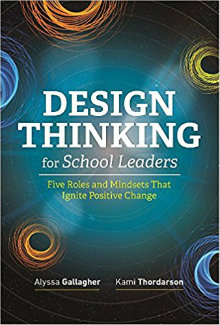Design Thinking for School Leaders
Design Thinking for School Leaders: Five Roles and Mindsets That Ignite Positive Change
By Alyssa Gallagher and Kami Thordarson
(ASCD, 2018 – Learn more)

“Insanity is doing the same thing over and over again and expecting different results.”
~ Unknown
Unfortunately this quote sums up the educational reform effort. We are trying to fix 21st century problems with 19th century solutions. To get out of this cycle, we need to think about our problems in a different way. A new way of thinking and attacking our educational problems is what Gallagher and Thordarson describe in their book, Design Thinking for School Leaders.

Empathy Is King
The most important part of this process is empathy, as is evident by the title of Chapter 2, “Empathy Is King.” The authors take us through the process of how we can be more empathetic to the end users and therefore design a product, idea, etc. that meets their needs. Some of the highlights are the Empathy Interview, Active Listening, the Five Whys, What If . . ., and the Premortem.
All of these techniques help the designer get to bottom of what the end user (the students, teachers, staff, etc.) really need, to help the designer to ideate, prototype and test a solution for that need, and finally to guide the designer in helping the end user get over the anxiety of the change process.
Leading like Designers
The next five chapters are dedicated to the roles and/or mindsets that school leaders can take to help them lead like designers. I found these five chapters to be most helpful because they allow you, as the reader, to identify the roles and/or mindsets that you are most comfortable with, the ones that match your personality and leadership style.
- Opportunity Seeker – finds opportunities where others see problems.
- Experience Architect – is “’a person who maps out how to turn something ordinary into something extraordinary’ (Kelley, 2005)” (p. 63).
- Rule Breakers – are those people willing to break those rules or routines that aren’t designed for the learner.
- Producer – is a person who will do one little thing each day to get your school moving in the right direction.
- Storyteller – is a person who can use their stories to show people a future that they may be afraid to imagine.
Envisioning the Ways to Accomplishments
The last chapter helps a school leader envision what a design team can accomplish and also understand the most important fact – that change doesn’t have to happen in large chunks. I found this book allowed me to envision the possibilities that we can create for kids without focusing on the obstacles. “Our advice is to start where you are and start with whatever problem is in front of you.” (p. 182)
Brian Taylor is the Director of Science and Engineering Technology K-12 for the West Islip Union Free School District on Long Island, New York. He has also been a Dean of Students and a chemistry teacher.


































